Related Research Articles

Saks Fifth Avenue, originally A. Saks & Co., is an American luxury department store chain, with its origins in Andrew Saks' A. Saks & Co. store opened in Washington, D.C.'s F Street shopping district in 1867. Saks' flagship store is located on Fifth Avenue in Midtown Manhattan, New York City. The 1924 New York store on Fifth Avenue lent its street name to the chain which would be known by what was originally the moniker of its flagship store, Saks Fifth Avenue.

The Works Progress Administration was an American New Deal agency, employing millions of job-seekers to carry out public works projects, including the construction of public buildings and roads. It was established on May 6, 1935, by presidential order, as a key part of the Second New Deal.

Macy's is an American department store chain founded in 1858 by Rowland Hussey Macy. It became a division of the Cincinnati-based Federated Department Stores in 1994, through which it is affiliated with the Bloomingdale's department store chain; the holding company was renamed Macy's, Inc. in 2007. As of 2015, Macy's was the largest U.S. department store company by retail sales. As of May 1, 2021, there were 512 stores, including 11 flagships and 384 magnets, for a total of 395 core stores, and 58 neighborhood stores, 47 furniture galleries, 2 furniture clearance centers, 6 freestanding Backstage stores, 2 Market by Macy's and 2 stores converted to fulfillment centers with the Macy's nameplate in operation throughout the United States. Its flagship store is located at Herald Square in the Manhattan borough of New York City. The company had 130,000 employees and earned annual revenue of $24.8 billion as of 2017.
Kohl's is an American department store retail chain, operated by Kohl's Corporation. As of February 2013 it is the largest department store chain in the United States, with 1,158 locations, operating stores in every U.S. state except Hawaii. The company was founded by Polish immigrant Maxwell Kohl, who opened a corner grocery store in Milwaukee, Wisconsin in 1927. It went on to become a successful chain in the local area, and in 1962 the company branched out by opening its first department store. British American Tobacco Company took a controlling interest in the company in 1972 while still managed by the Kohl Family, and in 1979, the corporation was sold to BATUS Inc. A group of investors purchased the company in 1986 from British American Tobacco and took it public in 1992.

Broadway Stores, Inc., was an American retailer based in Southern California. Known through its history as Carter Hawley Hale Stores and Broadway Hale Stores over time, it acquired other retail store chains in regions outside its California home base and became in certain retail sectors a regional and national retailer in the 1970s and 1980s. The company was able to survive takeover attempts in 1984 and 1986, and also a Chapter 11 bankruptcy filing in 1991 by selling off most of its assets until August 1995 when its banks refusing to advance enough additional credit to pay off suppliers. At that point, the company sold itself to Federated Department Stores for $1.6 billion with the acquisition being completed on October 12, 1995.

Lord & Taylor was an American department store chain, which has now become an e-commerce retailer. It was America's oldest department store, staying in business from 1826 to 2021. At the time of its closure, the company maintained 38 stores and one outlet store. The flagship store at the Lord & Taylor Building on Fifth Avenue in New York City operated from 1914 until 2019.

116th Street–Columbia University is a local station on the IRT Broadway–Seventh Avenue Line of the New York City Subway. It is located at the intersection of Broadway and 116th Street in Morningside Heights, Manhattan, just outside the west gate to the main campus of Columbia University and the southeast corner of the Barnard College campus. The station is served by the 1 train at all times.

145th Street is a local station on the IRT Broadway–Seventh Avenue Line of the New York City Subway. Located at the intersection of Broadway and 145th Street in Hamilton Heights, Manhattan, it is served by the 1 train at all times.
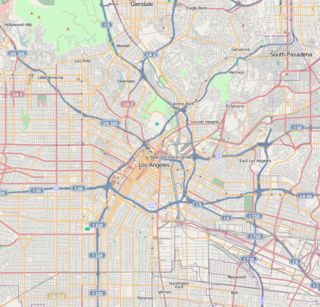
Broadway, until 1890 Fort Street, is a thoroughfare in Los Angeles County, California. The portion of Broadway from 3rd to 9th streets in the Historic Core of Downtown Los Angeles, was the city's main commercial street from the 1910s until World War II, and is the location of the Broadway Theater and Commercial District, the first and largest historic theater district listed on the National Register of Historic Places (NRHP). With twelve movie palaces located along a six-block stretch of Broadway, it is the only large concentration of movie palaces left in the United States.

86th Street is a local station on the IRT Broadway–Seventh Avenue Line of the New York City Subway. Located at the intersection of West 86th Street and Broadway on the Upper West Side of Manhattan, it is served by the 1 train at all times and the 2 train during late nights.

The Actors Fund of America is a 501(c)(3) charitable organization that supports performers and behind-the-scenes workers in performing arts and entertainment, helping more than 17,000 people directly each year. Serving professionals in film, theatre, television, music, opera, radio and dance, the Fund's programs include social services and emergency financial assistance, healthcare and insurance counseling, supportive and affordable housing, and employment and training services. The Fund owns and operates the Lillian Booth Actors Home, a skilled nursing and assisted living facility in Englewood, New Jersey.
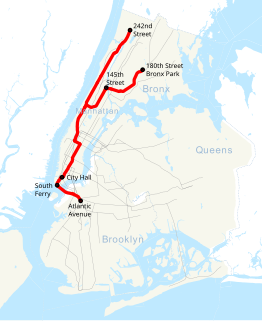
The first regularly operated subway in New York City was opened on October 27, 1904, and was operated by the Interborough Rapid Transit Company (IRT). The early IRT system consisted of a single trunk line below 96th Street in Manhattan, with three northern branches in Upper Manhattan and the Bronx, and a southern branch to Brooklyn. The system had four tracks between Brooklyn Bridge–City Hall and 96th Street, allowing for local and express service. The original line and early extensions consisted of:
Leonard Green & Partners ("LGP") is an American private equity investment firm founded in 1989 and based in Los Angeles. The firm specializes in private equity investments. LGP has invested in over 95 companies since its inception, including Petco and The Container Store.
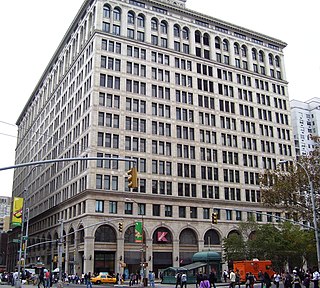
770 Broadway is a large mixed-use commercial office building in NoHo, Manhattan, in Lower Manhattan, New York City. The building occupies an entire square block between 9th and 8th Streets from north to south, and between Broadway and Fourth Avenue, from west to east. It was originally home to the now-defunct Wanamaker's department store.
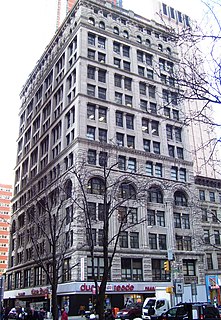
The Mutual Reserve Building, also known as the Langdon Building and 305 Broadway, is an office building at Broadway and Duane Street in the Tribeca neighborhood of Manhattan in New York City. The 13-story building, constructed between 1892 and 1894, was designed by William H. Hume and built by Richard Deeves, with Frederick H. Kindl as chief structural engineer. It is just east of the Civic Center of Manhattan, and carries the addresses 305–309 Broadway and 91–99 Duane Street.

The Lord & Taylor Building is an 11-story commercial building in Midtown Manhattan, New York City, that formerly served as Lord & Taylor's flagship department store in the city. It is at 424–434 Fifth Avenue, between West 38th and 39th Streets.
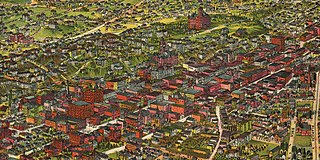
The late-Victorian-era Downtown of Los Angeles grew year by year, around 1880 centered at the southern end of the Los Angeles Plaza area, and over the next two decades, extending south and west along Main Street, Spring Street, and Broadway towards Third Street. Most of the 19th-century buildings no longer exist, surviving only in the Plaza area or south of Second Street. The rest were demolished to make way for the Civic Center district with City Hall, numerous courthouses, and other municipal, county, state and federal buildings, and Times Mirror Square. This article covers that area, between the Plaza, 3rd St., Los Angeles St., and Broadway, during the period 1880 through the period of demolition (1920s–1950s).

889 Broadway, also known as the Gorham Manufacturing Company Building, is a Queen Anne style building located at Broadway and East 19th Street in the Flatiron District of Manhattan in New York City, within the Ladies' Mile Historic District. Built in 1883–1884, it was designed by Edward Hale Kendall.

390 Fifth Avenue, also known as the Gorham Building, is an Italian Renaissance Revival palazzo-style building at Fifth Avenue and West 36th Street in the Midtown Manhattan neighborhood of New York City. It was designed by McKim, Mead & White, with Stanford White as the partner in charge, and built in 1904–1906. The building was named for the Gorham Manufacturing Company, a major manufacturer of sterling and silverplate, and was a successor to the former Gorham Manufacturing Company Building at 889 Broadway. The building features bronze ornamentation and a copper cornice.

The Home Life Building, also known as 253 Broadway, is an office building in Lower Manhattan, New York City. It is in Manhattan's Tribeca and Civic Center neighborhoods at the northwest corner of Broadway and Murray Street, adjacent to City Hall Park.
References
Notes
- 1 2 Staff. (February 1, 1894) "6-15-99 Club Is Growing" The New York Times , p.3
- ↑ Staff. (January 10, 1894) "New Scheme To Raise Money", The New York Times , p.9
- ↑ Staff. (April 8, 1894) "To Make More Money For The Poor", The New York Times , p.9
- ↑ "The Unemployed In American Cities", Quarterly Journal of Economics (1894) Volume 8, p.467
- ↑ Kellogg, Charles D. (1894) "The Situation In New York City The Winter Of 1893-1894" Journal of Social Science, volume 32, p.31.